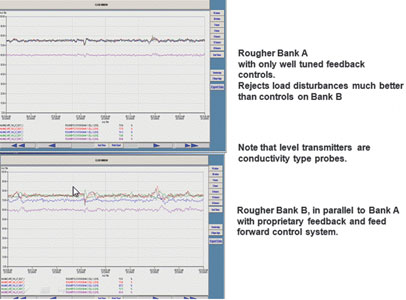
Recently, an Australian colleague of mine mentioned to me that he hates performing control loop optimisation in the mining industry. The reason he gave: “mines generally have not got a clue how to apply control systems.” Unfortunately I must agree with him to a very large extent.
I have previously written several Case Histories on the unique control problems encountered in mining beneficiation plants such as dealing with difficult materials like slurries, extremely tough environmental conditions, and other things, but there is no doubt that traditionally there is very little real knowledge on how to apply control system theory in the industry. This created enormous problems.
However, in recent years, senior mining management have changed their views of the importance of control as they realised how it could improve their bottom line, I am aware of at least three large mining groups who have invested quite a bit of money in training and analytical equipment in the past few years. But these efforts often run out of steam, mainly because no specialist optimisation teams get formed and existing plant C&I people get tasked with optimisation. This seldom works, as you need specialists who have the time and the experience to perform the difficult tasks of optimisation. You also need to get process experts like metallurgists involved, as optimisation is a joint effort involving both the process and the control specialists. Unfortunately very few metallurgists have any real understanding of the practicalities of feedback control.
Common erroneous concepts
1. Feedback control is simple and does not need experts to implement successfully.
2. Any control problem can be solved by tuning.
3. If there is a controller in the system then it can control anything.
4. One need not spend too much money on control systems, (like better measuring techniques and superior final control elements).
5. It is the instrument and control department’s job to sort out the controls, not metallurgical personnel.
6. If there is any fluctuation at all in the PV (process variable) signal then the control is not working properly. (Many mining processes are inherently very noisy.)
7. We have spent millions on a computerised control system. It looks after itself and I do not need specialised people to get it to work properly.
8. My control system has self tuning controllers, so I do not need anything else to get the controls working properly.
Other major problems I encounter frequently in this industry are bad plant design, from the control point of view, and very bad control strategies. The main reason behind this is that plants are generally designed by mining process specialists. I have met quite a few of these people and some are very experienced and have developed a ‘feel’ for control, but they do not really have experience of the practical aspects of it.
A couple of years ago I gave a course for about 12 top people from a large platinum mining group, half were metallurgists and the rest C&I specialists. One metallurgist in particular was a young and extremely bright lady who had taken an interest in control and was anxious to learn as much as she could. She pointed out that she was responsible for the operation of the platinum concentrator plant she worked in, and it was her task to get the controls to operate as well as possible. A couple of the C&I people were also very experienced.
The biggest complaint that these people had was that they had worked in various platinum concentrator plants and had come across serious design problems in all of them that prevented good control from being achieved. They had reported these problems time and time again to the plant design team, but every time a new plant was built, the same mistakes were made. This typical ‘head in the sand’ attitude is one which I have encountered time and time again.
Some common design problems I often encounter
1. Sumps with too short a retention time. The purpose of many, if not most sumps, is to act as a reservoir so that downstream processes can be fed at a constant rate. In other words the sumps act as surge vessels. Plant designers however often wish to keep the plant footprint down as small as possible and so make sumps and tanks as small as possible. One particular metallurgist I discussed this with said to me that it is fine if they are small as they use computerised level control equipment, which should keep the level as constant. He had completely missed the point that the object of the level controls in these cases is not to keep the level constant. The control is only there to prevent the level getting too high or too low, the level should be allowed to float gently between these two points.
2. Processes like flotation banks without a surge tank upstream to ensure a constant flow is fed into the bank.
3. Cutting costs wherever possible on control components, for instance cheap measuring transmitters and control valves, control valves need to be properly sized for effective control, proper sizing according to special sizing formulae that take all sorts of process conditions into account. Control valves that have been properly sized invariably end up at least one or two sizes smaller than the line. Full line sized control valves can be typically 4-6 times oversized, which is very bad for control, for reasons that are outside the scope of this article. Often not installing flowmeters in lines where one would like to measure the loads into certain processes, and on one particular plant I worked at, they refused to pay the extra cost for trending on the scada system. It is impossible to study plant operation and perform optimisation without having recordings of what is happening.
Put in perspective, I was recently asked by the manager of a mining plant to do a loop audit as there were extreme control problems and as a result experiencing really bad under-recovery. I was told they were extremely worried and losing a lot of money and was directed by the manager, a metallurgist, to work with an instrument & control person who had no real idea of what the manager wanted, or what the problems were from the metallurgical point of view. I did later meet a metallurgical consultant from the company’s head office, who had a long discussion with me and took a great interest in trying to ascertain what the problems were. I mentioned to him how important it is that the plant metallurgists need to take an active part in optimisation and should have a proper understanding of practical control. We made good progress at the plant after that.
Other typical control problems encountered in the mining industry:
1. PLC/Scada control systems are commonly employed in mining plants as opposed to the more sophisticated DCS type systems used in process industries where controls are considered more critical. There are valid reasons for the use of PLC/Scada, including expense and the fact that the ratio of digital to analogue I/O is very high in the mining industry. However, the control blocks in PLCs are generally far less sophisticated and are not protected sufficiently to guard against programmers mistakes and lack of knowledge of how controllers need to be set up. As a result of this I have found at least 85% of control systems using PLCs are programmed incorrectly so that good control and scientific tuning in particular becomes difficult if not impossible. Another problem is that often programmers do not know how to incorporate bumpless, balanceless switching between automatic and manual control and vice versa, so there can be huge process upsets when switching between the two modes.
2. Butterfly valves are often used in mining plants for modulating control purposes, as they are a cheaper alternative to high quality control valves. It is an old and well established practice in the control field that butterfly valves should only open to a maximum of about 65%. There are several reasons for this, the main ones being that once you move past this point the inherent flow characteristics of the valve change and in fact you get very little extra flow through them past that point. Therefore one should always stroke these valves so that when the controller output is at 100% the valve reaches 65%.
3. The purpose of cascade control is often not well understood. Cascade control is generally used on slow processes and its main purpose is to ensure that valve problems are taken care of in the fast slave flow loop, so that the correct flow is fed into the process as demanded by the output of the slower primary controller. This form of control is not used nearly enough in mining applications, where many slurry valves are relatively poor for control and need the help of the cascade flow loop. On one mining plant, we actually increased production through the plant by a whopping 5%, mainly due to judicious use of cascade controls.
Putting the theory into practice
To conclude this article I would like to show how well control can work if good equipment is used for measuring and controlling and if tuning is performed scientifically. I was recently asked to optimise a five tank flotation bank on a mine which had been performing badly and I worked with an extremely good C&I technician. We sorted out several controller set-up problems, and then optimised the bank. Fortunately the cell levels were measured with a new type of conductivity probe which performs absolutely brilliantly in comparison with the usual ultrasonic level transmitter measuring on a float/target system, which usually introduce long deadtimes into the loop.
Figure 1 shows the trend of the tank levels taken over a half-day period of two banks in parallel. The first, Bank A was running with only feedback control which we had just optimised. Bank B had been tuned by a company who specialises in control systems specifically for mining, and they make a special control system for flotation banks which incorporate feedback with feedforward control as well. It can be seen that Bank A was running much better. It even dealt better with surge load disturbances than the more sophisticated system, which it should not, as the feedforward part of the control is there to deal with surges.

The metallurgical consultant could not believe how well the more basic system was working and asked me why I thought it was performing better. Not knowing the other system, I could only reply that I guessed it either was not optimised properly, or else the design was bad. I really do not know, but it does show how well feedback control can work when systems are properly optimised and good quality control components are used.

Michael Brown is a specialist in control loop optimisation, with many years of experience in process control instrumentation. His main activities are consulting, and teaching practical control loop analysis and optimisation. He gives training courses which can be held in clients’ plants, where students can have the added benefit of practising on live loops. His work takes him to plants all over South Africa, and also to other countries. He can be contacted at Michael Brown Control Engineering cc, +27(0)11 486 0567, [email protected], www.controlloop.co.za
| Email: | [email protected] |
| www: | www.controlloop.co.za |
| Articles: | More information and articles about Michael Brown Control Engineering |

© Technews Publishing (Pty) Ltd | All Rights Reserved